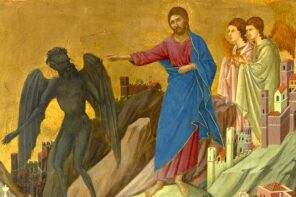Although it was a financial success, The Pope’s Exorcist, featuring a virile Russell Crowe as real-life exorcist Gabrielle Amorth, was panned by most Catholic reviewers, including the International Association of Exorcists (IAE), which Amorth founded. Critics objected to the film’s ignorance about how the Catholic Church actually works, the gratuitous violence, and Crowe’s macho swagger. But Sony Pictures seems to understand its audience. The excessive machismo around The Pope’s Exorcist reflects the politics of contemporary demonology: a worldview in which defeating Satan requires masculine men and skepticism is a sign of effeminacy rather than critical thinking.
The Pope’s Exorcist, which we note in our forthcoming book The Exorcist Effect, was “inspired by” and loosely based on the life of Gabrielle Amorth, who became exorcist to the diocese of Rome in 1986. In 1990 he founded the IAE to promote and de-stigmatize the practice of exorcism. In the film, Amorth doesn’t perform duties for the diocese of Rome, but is instead sent by the Pope to Spain. (No one seems certain whether this bearded Pope, played by Italian actor Franco Nero, is meant to be John Paul II or simply a fictional Pope.) There, Amorth goes spelunking beneath an abandoned monastery and discovers a conspiracy to cover up the fact that the Spanish Inquisition actually happened because demons possessed Church authorities.
Adding to the pageantry, Crowe did a version of his Amorth character for Wrestlemania 39 to introduce a match called “hell in a cell.” The message from this cross-promotion seems clear: exorcism isn’t a matter of prayer so much as it is a spectacle pitting man against demon. Ironically, however, Slate’s Molly Olmstead argues that this is why the real-life exorcists of the IAE did not like the film. “Many exorcists will try to present an exorcism not as a dramatic battle with the devil,” she writes, “but as a boring task—and a simple prayer of healing.”
A reviewer for Catholic World Report called The Pope’s Exorcist “even worse than I expected.” The IAE panned it as “splatter cinema.” Father Vincent Lampert, IAE member and exorcist to the diocese of Indianapolis, said it focused more on Satan than Amorth and his ministry. The IAE also objected that the bearded Crowe looked nothing like the actual Amorth, who once said the devil fears him because, “I’m uglier than him.”
But a Catholic priest was also instrumental in creating the Amorth biopic. According to Deepa Bharath of the Associated Press, producers Michael Patrick Kaczmarek and Edward Siebert persuaded Amorth to sign over his movie rights. Siebert, a Jesuit priest who teaches film classes at Loyola Marymount University, expressed some anxiety about the film but concluded, “It feels good to finally see a priest as a hero.”
Religion scholar Michael Cuneo credits The Exorcist (1973) with popularizing the trope of the “hero-priest.” That film won endorsements from Catholic clergy in part because of the way it portrayed priests. In 1974, a priest told tabloid The Tattler, “Of all the Hollywood movies I’ve seen that include priests—usually they are a 55-year-old Irishman with a pot, the typical Hollywood monsignor—in this film, the priests are human beings.” Similarly, the saving grace of The Pope’s Exorcist is that Crowe’s Amorth is a complete character who jokes, feels guilt, drinks, and uses holy water to scrub his armpits when he thinks no one’s looking.
But The Exorcist also premiered amidst the conservative backlash over Vatican II. In the 1970s many conservative Catholics viewed modernity as demonic and wanted priests who could lead the culture war against these forces. Religion scholar Mark Jordan notes that priests have traditionally, if unintentionally, challenged gender roles because they’re celibate and take on domestic duties that are often assigned to women. By contrast, The Exorcist’s Father Karras is a boxer who grew up in the slums. When not investigating the demonic, he’s shown either working out or drinking and smoking with his fellow Jesuits. Now, this was the sort of priest who could fight for traditionalism.
Significantly, Amorth named The Exorcist as his favorite film. In his 1999 book An Exorcist Tells His Story, Amorth wrote, “It is thanks to movies that we find a renewed interest in exorcisms.” And in 2017, Friedkin filmed one of Amorth’s exorcisms for his documentary The Devil and Father Amorth, completing the cycle of film and reality.
Big movie studios study their audiences, and they discovered they could expand the market for horror movies by pitching them to Christians as “religious supernatural” films. Sony Pictures saw a demand for “tough priests” and took it to its logical conclusion, serving up a hero-priest on steroids. Amorth cruises around Rome on a Vespa as Faith No More sings, “It’s a dirty job, but someone’s gotta do it.” Flashbacks show him fighting literal Nazis as a partisan in World War II. And in an opening scene he blasts a pig with a shotgun in what seems like a violent parody of the gospel story of the Gerasene demoniac in which Jesus exorcizes demons and sends them into a herd of pigs who proceed to drown themselves in the sea.
Amorth’s tough guy persona is further enhanced by giving him an effeminate nemesis in the form of Cardinal Sullivan, the skeptical head of the Congregation for the Doctrine of Faith (CDF). The film is set in 1987, when the future Pope Benedict XVI, Joseph Ratzinger, was head of the CDF and supported the idea of a literal Satan. The fictional Cardinal Sullivan is American and appears several decades too young to have attained the rank of cardinal. More importantly, Sullivan appears shrill and ineffectual as he scolds Amorth for his exorcisms. Amorth, who man-spreads through his meeting with the CDF, orders a nun to bring him a double espresso before storming out. The dynamic between Amorth and Sullivan is reminiscent of Ghostbusters, in which an antagonist from the EPA is likewise depicted as both skeptical and effete.
While Catholic critics found all this machismo a bit gauche, The Pope’s Exorcist was financially successful, in part because its low $18 million budget made it easy to turn a profit, but largely because it reflects the increasingly popular worldview on the Right that we’re engaged in a battle of good vs. evil and that our only hope is for hypermasculine men with unshakable Christian conviction to save us. Indeed, in the film’s denouement, Amorth and his sidekick defeat the demon Asmodeus. Of course, this is a business, so their victory is followed by the discovery that there remain 199 demons around the world. The first sequel is already in development.
Meanwhile, exorcisms have become increasingly mainstream in the Catholic Church and increasingly political, framing gay rights, abortion access, and other social issues as “demons” to be combatted and banished. So long as the triad of supernaturalism, masculinity, and cultural grievance remains, we’re likely to see more films like The Pope’s Exorcist. More importantly, we’re likely to see more assaults on the rights of women and LGBTQ+ people.





